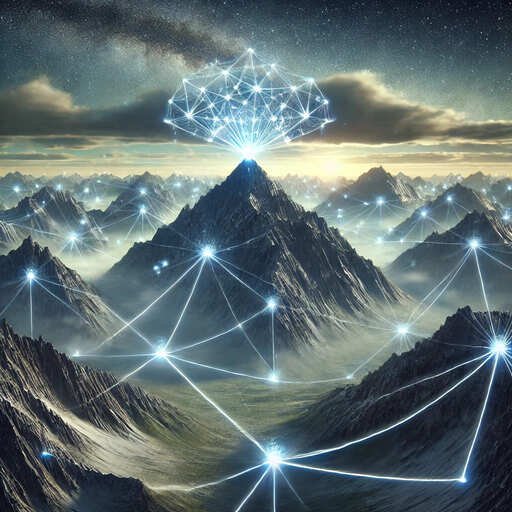
Introduction: The Centralized Mountain vs. the Multi-Agent Range

In the ever-evolving landscape of system architecture, the fundamental choice between centralized and multi-agent systems dictates the resilience, efficiency, and adaptability of our technological creations. To grasp this distinction, let us envision two contrasting geographical forms: a solitary, imposing mountain, and a vast, interconnected mountain range. The lone mountain symbolizes the traditional centralized system, a monolithic entity where control, processing, and decision-making are funneled through a single, central unit. This approach, while seemingly straightforward, carries inherent vulnerabilities. Like a single mountain susceptible to erosion or collapse, a centralized system is fragile; failure at the central point can cripple the entire operation, leading to system-wide disruption and potential data loss.
Conversely, picture a sprawling mountain range, a dynamic and distributed network of peaks and valleys. This represents the essence of a Multi-Agent System (MAS), where numerous autonomous agents, akin to individual mountain peaks, interact and collaborate to achieve a common goal.
This distributed architecture offers a stark contrast to the centralized model, fostering inherent resilience and unparalleled adaptability. As we venture deeper into the digital age, confronting increasingly complex challenges – from managing intricate global networks and orchestrating smart cities to developing sophisticated artificial intelligence and tackling large-scale data analysis – the limitations of centralized systems become increasingly pronounced. Multi-Agent Systems emerge not merely as an alternative, but as a superior paradigm, offering a more flexible, robust, and inherently efficient methodology to navigate and conquer these multifaceted challenges [1].
This article will embark on a detailed exploration of the key advantages that MAS hold over their centralized counterparts, illuminating why they are rapidly becoming the preferred architectural choice for tackling the ever-growing mountains of complexity in the technological landscape of today and tomorrow. We will delve into seven core advantages, each demonstrating how MAS provide a more robust, scalable, and intelligent approach to system design in an increasingly interconnected and complex world.
Advantage 1: Conquering Fault Tolerance – Navigating Mountainous Terrain
One of the most compelling and mission-critical advantages inherent in Multi-Agent Systems is their demonstrably superior fault tolerance. To truly appreciate this benefit, imagine the precariousness of traversing a rugged, mountainous terrain. A centralized system, in this analogy, is akin to a single, precarious path winding its way up a steep mountain slope.
Should a landslide occur, blocking this solitary route, the entire journey grinds to a halt, leaving travelers stranded and the objective unreached. In stark contrast, a MAS mirrors the strategic advantage of having multiple, interconnected paths and a team of experienced climbers (agents) expertly navigating a sprawling mountain range. If one path becomes impassable due to unforeseen obstacles or if a climber encounters difficulties, the others can seamlessly adapt, reroute, and continue the ascent, ensuring the overall expedition remains on course and the summit is eventually reached [1].
In essence, Multi-Agent Systems are fundamentally architected to maintain operational continuity even in the face of individual agent failures. This inherent resilience is not merely a desirable feature; it is a core tenet of their design, stemming directly from their distributed and decentralized nature.
Should one agent within the system encounter a malfunction, whether due to software glitches, hardware failures, or external disruptions, the remaining agents are empowered to dynamically compensate, intelligently re-organize tasks, or seamlessly take over the responsibilities of the incapacitated agent. This remarkable adaptability is not just theoretically advantageous; it is absolutely crucial in mission-critical applications where system downtime is simply unacceptable, such as air traffic control, nuclear power plant management, or emergency response systems. As highlighted in Botpress’s comprehensive guide to Multi-Agent Systems in 2025, MAS are specifically designed to maintain their core activities and functionalities even when individual agents falter, as the remaining agents possess the intelligence and capability to adapt and seamlessly assume the critical roles [1].
Wikipedia further reinforces this crucial aspect, emphasizing that within a MAS framework, the malfunction of a single agent does not equate to system-wide failure; rather, the collective of agents ensures continued operation and robustness [3]. This inherent fault tolerance, deeply embedded in the MAS architecture, renders them exceptionally well-suited for deployment in environments as inherently unpredictable, dynamically challenging, and potentially hazardous as a real-world mountainous environment, where resilience is not just a benefit, but a necessity for survival and success.
Advantage 2: Scaling New Heights – The Scalability Mountain
Scalability represents another formidable mountain that traditional centralized systems often find insurmountable, while Multi-Agent Systems are engineered to ascend with remarkable agility and efficiency. Centralized systems, by their very nature, frequently encounter performance bottlenecks as workload demands incrementally increase. Envision the arduous task of constructing and maintaining a single road leading to the summit of a mountain.
As traffic volume grows, widening this solitary path becomes exponentially more complex, costly, and disruptive, eventually reaching a point of diminishing returns and potential gridlock. Multi-Agent Systems, in stark contrast, are inherently and elegantly scalable. The process of augmenting a MAS to effectively handle escalating workloads is as straightforward as adding more agents to the network. This is analogous to strategically adding more parallel paths up the mountain range – a significantly more manageable, cost-effective, and inherently efficient approach to increasing capacity and throughput [1].
This concept of horizontal scalability constitutes a fundamental strength and defining characteristic of MAS architecture. As the operational demands placed upon a system progressively grow, the solution is not to drastically overhaul the core infrastructure, but rather to simply and strategically integrate additional agents into the existing network.
This seamless integration of new agents effectively distributes the burgeoning workload across a wider pool of processing power and intelligence, proactively preventing the emergence of performance bottlenecks and ensuring sustained optimal system performance even under heavy load. Botpress astutely emphasizes this critical scalability advantage, explicitly stating that MAS are uniquely positioned to effortlessly manage continuously increasing workloads simply by incrementally adding agents as operational needs dictate [1].
This inherent scalability is not merely a theoretical advantage; it is absolutely vital in today’s relentlessly data-driven and computationally intensive technological landscape, where systems are perpetually challenged to adapt and respond to ever-escalating demands for processing power, data handling, and real-time responsiveness. Multi-Agent Systems provide a uniquely flexible, dynamically adaptable, and fundamentally efficient mechanism for achieving true scalability, empowering systems to effortlessly reach unprecedented performance heights, much like a skilled mountaineering team confidently conquering a towering mountain peak, step by strategic step.
Advantage 3: Problem Solving Prowess – Mapping Complex Mountain Systems

The domain of complex problem-solving can be aptly likened to the daunting task of meticulously mapping and navigating a vast and intricately interconnected mountain system. Centralized systems, with their inherently singular, top-down approach to problem-solving, often struggle to effectively chart, analyze, and ultimately resolve the multifaceted challenges presented by such complex terrains. Multi-Agent Systems, however, are specifically designed to excel in precisely these types of intricate and distributed problem domains. By leveraging the collective intelligence of multiple agents, each strategically focused on a distinct facet of the overarching task, complex problems are tackled with remarkable efficiency, particularly within distributed operational environments [1].
Each individual agent within a Multi-Agent System possesses the capacity to concentrate its computational resources and specialized algorithms on a narrowly defined, specific aspect of the larger problem. This division of labor, coupled with specialized expertise, mirrors the effectiveness of assembling multiple teams of highly skilled explorers, each tasked with charting and analyzing different routes and features within a sprawling mountain range. These specialized agents operate concurrently, leveraging parallel processing to accelerate problem decomposition and solution generation.
Crucially, they are also designed to communicate and collaboratively share vital information, insights, and partial solutions with one another. This dynamic information exchange allows the collective intelligence of the agent network to emerge, leading to the synthesis of comprehensive and robust solutions that would be virtually unattainable for a monolithic, centralized system attempting to grapple with the entire problem in isolation.
Botpress directly highlights this distributed problem-solving advantage, explicitly noting that the deployment of multiple agents, each working on distinct parts of a complex task, enables a significantly more effective and efficient approach to handling intricate problems, especially within distributed operational contexts [1]. This inherent problem-solving prowess, deeply rooted in the collaborative and distributed nature of MAS, makes them exceptionally well-suited for tackling the most challenging, computationally intensive, and intellectually demanding “mountainous” problems that define the cutting edge of modern technology and scientific inquiry.
Advantage 4: Flexibility and Adaptability – Weathering Mountain Storms
In today’s increasingly volatile, uncertain, complex, and ambiguous (VUCA) world, characterized by dynamic and often unpredictable operational environments, the attributes of flexibility and adaptability are no longer merely desirable system features – they are absolutely mission-critical imperatives for sustained success and resilience. Centralized systems, inherently rigid and monolithic in their design, are akin to a lone, isolated mountain peak, standing tall but ultimately vulnerable to the sudden onslaught of unforeseen storms and abrupt environmental shifts. Multi-Agent Systems, in stark contrast, inherently embody remarkable flexibility and adaptability, mirroring the resilience of a vast mountain range that effectively weathers even the most severe storms through the distributed strength and independent responsiveness of its myriad interconnected peaks [1].
Each autonomous agent within a Multi-Agent System is meticulously designed to possess the capacity to react independently and intelligently to changes and perturbations within its immediate, localized environment. This inherent responsiveness, distributed across the agent network, empowers the system as a holistic entity to adapt swiftly and seamlessly to newly emergent conditions, unexpected disruptions, or entirely unforeseen operational scenarios. Botpress explicitly underscores this crucial advantage, meticulously explaining that the inherent ability of each agent to autonomously react to environmental changes is the very mechanism that enables the entire system to achieve rapid and effective adaptation to novel conditions or entirely unanticipated scenarios [1].
This inherent flexibility and dynamic adaptability are not merely theoretical benefits; they are absolutely paramount in operational environments fundamentally characterized by uncertainty, volatility, and continuous flux, where systems must possess the intrinsic capacity to proactively “weather the storm,” dynamically adjust to changing circumstances, and maintain uninterrupted, effective functionality. Multi-Agent Systems inherently provide the requisite agility, responsiveness, and adaptive capacity needed to not only survive but to actively thrive in such dynamic and often turbulent “mountainous” landscapes, where predictability is a rare commodity and resilience is the ultimate competitive advantage.
Advantage 5: Autonomy at the Summit – Independent Mountain Agents
Autonomy stands as a truly defining characteristic of Multi-Agent Systems, bestowing upon them a strategically significant and often decisive competitive edge when contrasted with the operational limitations of centralized systems. To fully grasp the transformative power of agent autonomy, envision each agent not merely as a climber on a mountain, but as a highly skilled and independent mountaineer who has successfully reached the summit of a mountain peak. From this elevated vantage point, each agent possesses a unique, localized perspective of the surrounding environment, empowering it to make informed, real-time decisions based on the specific conditions and challenges it directly perceives.
This inherent autonomy, distributed across the agent network, imbues MAS with a level of dynamism, responsiveness, and proactive adaptability that centralized systems, with their reliance on top-down control, simply cannot replicate [2].
Every agent within a Multi-Agent System is meticulously engineered to exhibit self-guided behavior, operating as an autonomous entity capable of formulating and executing independent decisions grounded in its individual perceptions and interpretations of the immediate operational environment [2]. This inherent agent autonomy is not merely a design principle; it is the fundamental mechanism that empowers the entire system to dynamically adapt and intelligently respond to unforeseen changes, emergent complexities, and unpredictable disruptions within the operational landscape [3]. Nugg.ad, in its comprehensive definition of Multi-Agent Systems, accurately highlights agent autonomy as a core characteristic, emphasizing that each agent inherently possesses self-guided behavior, enabling it to engage in independent decision-making processes based on its unique and localized perceptions [2].
Wikipedia further underscores the critical importance of autonomy, explicitly stating that this distributed autonomy is the key enabler for MAS to achieve dynamic adaptation to unforeseen environmental changes and operational uncertainties [3]. This pervasive and distributed autonomy is not merely a subtle differentiator; it represents a paradigm shift in system design, fundamentally enabling MAS to operate with remarkable effectiveness, resilience, and proactive intelligence in complex, dynamic, and inherently unpredictable “mountainous” operational situations where rigid, centralized control mechanisms would prove to be excessively slow, inherently brittle, and ultimately inadequate for navigating the ever-changing terrain.
Advantage 6: Decentralization – A Network of Mountain Peaks

Decentralization serves as the very bedrock upon which the inherent resilience, scalability, and operational efficiency of Multi-Agent Systems are firmly established. In stark contrast to centralized system architectures, which are fundamentally predicated on a single, central point of control, Multi-Agent Systems strategically distribute both decision-making authority and data processing responsibilities across a dynamic network of interconnected, yet autonomous, agents.
To fully appreciate the profound implications of this decentralized approach, envision a majestic mountain range stretching across the horizon. Within this vast and interconnected landscape, no single mountain peak unilaterally dictates the behavior or overall functionality of the entire range. Instead, each individual peak (agent) operates with a degree of autonomy, contributing its unique characteristics and localized influence to the collective dynamism and overall resilience of the entire mountain system.
Within a Multi-Agent System, each agent is meticulously designed to function as an independent operational unit, leveraging locally sourced data and executing its own decision-making processes without requiring constant or direct oversight from a centralized command-and-control authority [1]. Botpress explicitly underscores this fundamental principle of decentralization, clearly articulating that each agent within a MAS operates autonomously, intelligently utilizing local data streams and engaging in independent decision-making, effectively eliminating the traditional reliance on a monolithic central controller [1]. This inherently distributed architectural paradigm strategically eliminates single points of failure, which are the Achilles’ heel of centralized systems, and proactively mitigates the emergence of performance bottlenecks that can severely constrain scalability and responsiveness.
Decentralization fundamentally empowers Multi-Agent Systems to function as a highly adaptable and robust network of interconnected “mountain peaks,” with each agent contributing its unique processing power, localized intelligence, and collaborative capacity to the system’s overarching intelligence and operational capabilities. This distributed and collaborative model renders MAS demonstrably more resilient, inherently scalable, and significantly more adaptable than their centralized “mountain” system counterparts, particularly when confronted with the complexities and uncertainties of real-world operational environments.
Conclusion: The Multi-Agent Advantage – Mastering the Mountains of Complexity
Multi-Agent Systems represent far more than just an incremental improvement in system design; they embody a fundamental paradigm shift, offering a compelling and demonstrably superior alternative to the limitations inherent in traditional centralized architectural approaches. As we have meticulously explored and rigorously analyzed throughout this discourse, the multifaceted advantages of MAS are not merely theoretical constructs – they are tangible, operationally significant, and increasingly critical for navigating the ever-escalating mountains of complexity that define the modern technological landscape and the challenges of the 21st century.
From the critically important enhancement of fault tolerance and the virtually limitless potential for horizontal scalability to the demonstrably superior capabilities in complex problem-solving, the inherent flexibility and dynamic adaptability, the empowering nature of distributed agent autonomy, and the foundational resilience afforded by decentralized architectures, Multi-Agent Systems collectively provide a uniquely robust, profoundly adaptable, and inherently intelligent framework for effectively tackling the intricate and dynamic challenges that lie ahead.
The illustrative metaphor of a sprawling mountain range juxtaposed against a solitary, centralized mountain has served as a powerful and intuitive lens through which to understand and appreciate the core strengths and inherent advantages of Multi-Agent Systems. Just as a diverse and interconnected mountain range exhibits far greater resilience, adaptability, and overall robustness than a single, isolated peak, so too do MAS offer a demonstrably more robust, inherently scalable, and ultimately more intelligent solution for designing and deploying complex systems in an increasingly interconnected and unpredictable world.
As technological innovation continues to accelerate at an unprecedented pace, and as the operational challenges we collectively confront become progressively more complex, multifaceted, and dynamic, Multi-Agent Systems are not merely poised to become a dominant architectural paradigm – they are rapidly emerging as an indispensable technological imperative, holding the key to effectively mastering the ever-growing mountains of complexity and uncertainty that characterize the future of technology and human endeavor in the 21st century and beyond.
References:
[1] Guide to Multi-Agent Systems in 2025 – Botpress. https://botpress.com/blog/multi-agent-systems
[2] Multi-Agent Systems (Systèmes multi-agents) – Nugg.ad. https://nugg.ad/fr/glossaire-ia/systemes-multi-agents/
[3] Multi-agent system – Wikipedia. https://en.wikipedia.org/wiki/Multi-agent_system
4 Les Systèmes Multi-Agents – Support de cours – ResearchGate. https://www.researchgate.net/publication/374902666_Les_Systemes_Multi-Agents_-_Support_de_cours
[5] [PDF] Systèmes multiagents : Principes généraux et applications. http://www.sietmanagement.fr/wp-content/uploads/2017/12/Chaib-draa2001.pdf
[6] [PDF] SYSTÈMES MULTI-AGENTS : UNE ANALYSE COMPARATIVE DES … https://depot-e.uqtr.ca/id/eprint/2749/1/000685703.pdf
[7] [PDF] Les Systèmes Multi-Agents (SMA) – E-learning. https://elearning.univ-msila.dz/moodle/mod/resource/view.php?id=27112
[8] [PDF] Agents et systèmes multi-agents : vers une synthèse de ces concepts.
[9] How AI Agents Are Revolutionizing Customer Service in 2025 https://smartgnt.com/ai-in-customer-service/




[…] AI Scalability : Scaling Mountains: 7 Advantages of Multi-Agent Systemshttps://smartgnt.com/multi-agent-systems/ […]
[…] AI functions as a multi-agent system powered by several distinct models4. It leverages Large Language Models (LLMs), multi-modal […]